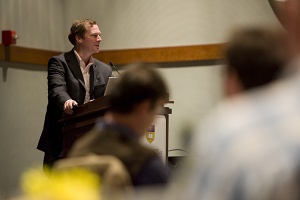Nov 18 2008
Internationally recognized research leader and lecturer Andrew Maynard, chief science adviser to the Project on Emerging Nanotechnologies, clarified the public perception of research and risk surrounding nanotechnology at the "Environmental Nanoparticles: Science, Ethics, and Policy" conference held Nov. 10-11 at the University of Delaware.
 Internationally recognized research leader Andrew Maynard discussed nanotechnology during a conference held Nov. 10-11 at the University of Delaware. Photo by Tyler Jacobson
Internationally recognized research leader Andrew Maynard discussed nanotechnology during a conference held Nov. 10-11 at the University of Delaware. Photo by Tyler Jacobson
The Project on Emerging Nanotechnologies is a Washington, D.C.-based partnership between the Woodrow Wilson International Center for Scholars and the Pew Charitable Trusts that works closely with government, industry and environmental groups to support science-based decision-making in the development of responsible nanotechnologies.
In his keynote speech, Maynard used humor to remind his diverse audience, which included scientists, engineers, ethicists and science policy experts, of basic concepts: “nano” means “very small,” he said, and “nanotechnology is the science of “making very small stuff that does stuff.”
He assured the crowd that if they learned the language of nanotechnology, “You might suddenly find you're speaking the same language as the person next to you.”
Maynard kept conference attendees laughing, even as he delved into more serious topics, like the fact that scientists and the public regard nanotechnology as a technical revolution, yet nanoparticles are in more and more products, and no one is sure exactly what happens when nanoparticles get released into the environment.
Maynard emphasized the need to “explore the unknown from what is known,” explaining that a typical research question asked by scientists in relation to nanoparticles occurs when “a conventional material is engineered to have a nanoscale structure and begins to behave in unconventional ways.”
Showing images of material with different shapes, all of which were formed from the same chemical, zinc oxide, Maynard noted that things with “similar chemistry have potentially different risks.”
Maynard offered an example to illustrate the importance of maintaining a sense of perspective when studying nanoparticles. “There is a possibility that iron is more hazardous when engineered at the nanoscale,” he said. “Do you ban all uses of nanoscale iron or weigh the probability that iron is dangerous?”
The audience's response underscored Maynard's point that when dealing with such research questions, it is critical to take probability into account. How to measure probability? “If you're lucky, and you've got hard data, you can conduct a risk assessment,” said Maynard, but if not, one must rely upon one's professional judgment to assess potential risks.
It is also important to consider impacts, Maynard said. “Long carbon nanotubes look like asbestos. What if someone inhales it?” Though the probability of that happening is low, the consequences of even one incident occurring are very serious, he said. “This is a situation when the potential implications justify weighing the probability against the consequences.”
Maynard closed his talk with a quote from Douglas Adams: “Don't panic!”
The environmental nanoparticles conference was co-sponsored by UD's Center for Critical Zone Research (CCZR) and the Science, Ethics and Public Policy (SEPP) program, both of which are outgrowths of the Delaware EPSCoR program, funded by the National Science Foundation to develop environmental science research capabilities in Delaware. The NSF and Delaware EPSCoR provided financial support for the conference, which was attended by 100 people.
CCZR Director Donald Sparks and SEPP Director Thomas Powers decided to host the conference to foster better understanding of nanoparticles. Conference presentations addressed the characterization, reactivity, fate, and transport of nanoparticles, their impacts on human and environmental health, their usefulness in sensing and remediation and future nanotechnology policy directions.